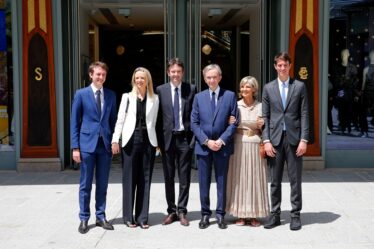
The luxury fragrance brand Aeir may have launched online, but it’s staking its future on its ability to catch customers’ eyes — and noses — in the real world.
Aeir’s physical retail debut is an installation inside Neiman Marcus’ Beverly Hills store slated to open in January (the brand began selling its fragrances on its website in September). From a stand designed to resemble a Milanese news kiosk, employees will help customers determine which top and base notes work best for them. Along the way, shoppers will hopefully be convinced that Aeir’s $69-and-up scents are just as luxurious as the Jo Malone or Tom Ford fragrances stocked nearby.
Wholesale was baked into the brand’s DNA from the start, said Jana Bobosikova, co-founder and chief operating officer.
“Fragrance is emotional,” Bobosikova said. “For us to be successful at retail is very important.”
Aeir joins other emerging, digital-native brands that see direct-to-consumer sales as one channel among many, rather than a goal unto itself. In embracing wholesale retail from the get-go, they’re charting a different path than brands that came up during the DTC boom of the last decade, many of which raised hundreds of millions of dollars to operate online storefronts — and eventually their own brick-and-mortar locations.
They’re also benefiting from some big shifts in the retail landscape. Multi-brand retailers that used to control how brands were priced and marketed are relying on up-and-coming brands to differentiate their offerings and bring in younger, cooler shoppers. In the decade since Nordstrom first began stocking Bonobos pants, they’ve gotten better and better at promoting small, digital-first start-ups.
Meanwhile, digital brands that cut out the retail middleman discovered much of the money they saved went to marketing. A growing number now see wholesale as a way to grow beyond the niche customer base they’ve built online: Allbirds has begun selling its popular wool runners in Nordstrom, Glossier has a partnership with Sephora and Parade’s intimates are stocked at Urban Outfitters.
Still, the old problems with wholesale remain — it’s difficult for brands to get customer data from third-party retailers, and there’s no guarantee that shoppers who discover brands in a department store will follow those merchants back to their website. Not every in-store display can be as meticulously on-brand as Aeir’s Milanese newsstand.
The sacrifices can be worth it: brands that structure their wholesale partnerships in the right way, and with the right retailers, can get themselves in front of a bigger pool of potential customers.
“There’s a lot of people going into a shopping journey not knowing which brand they want,” said Tom Nikic, a senior apparel and footwear analyst at Wedbush Securities. “That’s why people still go to Nordstrom.”
One Piece of the Puzzle
Before diving into wholesale, DTC brands need to decide whether they’re looking for their new retail channel to directly boost sales or to primarily serve as a form of marketing.
Bala Footwear launched its online store in January 2021, selling high-performance sneakers for healthcare professionals in five colours. It landed its first wholesale accounts a little over a year later, starting with smaller retailers like Shoe Mill in Oregon and Jenkintown Running Company in Pennsylvania before expanding into Scrubs and Beyond, which has 116 US locations.
Before it launched in retail partners’ stores, company executives helped train sales associates on how to explain to customers that Bala Footwear’s fit technology addresses the specific needs of healthcare workers who spend long stretches on their feet, said Brian Lockard, the company’s co-founder and chief executive.
Bala Footwear started with smaller retailers to hone its selling methods in those locations, so when it partnered with bigger retailers, its sales could grow quickly. The company expects anywhere from 50 to 60 percent of its overall sales will come from wholesale in the next two to three years, he said.
Meanwhile, Aeir is working with a handful of high-profile third-party retailers, including Violet Grey in Los Angeles and Dover Street Market in Paris. (Aeir is slated to sell its scents in those stores sometime next year). Its goal is to drive brand awareness as much as sales; it anticipates wholesale will represent up to 15 percent of overall revenue by the end of next year.
The DTC veteran Allbirds also said it would take a similar approach when the company announced its wholesale expansion earlier this year.
“We view third-party [retail] as a highly effective way to build awareness and drive credibility, while accelerating top and bottom line growth,” Joey Zwillinger, Allbirds’ co-founder and co-CEO, said on a May earnings call.
Considering the Customer
DTC start-ups, especially those with an established following, also need to determine which wholesale partners will help drive consumers back to the brand.
Athletic Propulsion Labs, which launched its digital storefront in 2010, began selling its trainers, priced at $200 and up, on Net-a-Porter and at Saks Fifth Avenue stores in 2015. The brand went on to open its first brick-and-mortar store in 2019 in The Grove, a shopping centre in Los Angeles.
Since only a select number of items are sold in outside retailers, most of APL’s customers still buy its wares on the brand’s site and in its store, with some of those clients coming to APL after discovering the brand at one of its retail partners.
“Customers from other channels come to us to have the full and complete APL experience,” said NJ Falk, a managing partner at Athletic Propulsion Labs. “They come to us for limited editions and exclusives.”
The challenge of finding the perfect partner has made some legacy DTC outfits slower to embrace wholesale.
ThirdLove is looking to expand its wholesale channel after nearly a decade of mostly direct sales, said Heidi Zak, the brand’s co-founder and CEO. The intimates brand, which operates six standalone stores in the US, currently sells on luxury e-tailer 11 Honoré.
The biggest hurdle for ThirdLove as it considers widening its wholesale distribution to physical stores is making sure potential retail partners are able to replicate ThirdLove’s service fitting customers with a complex range of bra sizes in the company’s wares.
The question is “what are we willing to sacrifice,” Zak said. “With 65 sizes in bras … how does that work for the end customer?”
Zak said that upscale department stores with skilled customer associates who are used to delivering a high level of service would be the best option.
The Data Divide
While multi-brand retailers may be willing to listen to start-ups when it comes to marketing or training their salespeople, they’re often still reluctant to hand over customer data, including insights about which shoppers are buying which brands and why.
There are workarounds. Aeir is launching a subscription service, Aeir ID, so it will be able to connect directly with customers, even if they bought a fragrance at Neiman Marcus or Dover Street Market. Customers who scan their barcodes in a store and pay a $69 fee will gain access to exclusive merchandise on the company’s site and mobile app, said Rodgrigo Caula, Aeir’s co-founder and chief brand officer.
Bala Footwear is focused on building trust with its retail partners, which CEO Lockard says will lead to conversations about sharing data on which customers are buying the company’s sneakers.
“The foundational issue in retail is lack of trust, and that takes time,” Lockard said.



